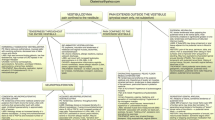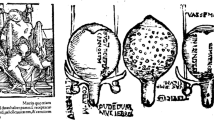Abstract
The vulvar vestibule is the tissue located between the vagina and the vulva, comprising the vaginal introitus. It is mainly considered in the context of localized provoked vestibulodynia, a pain condition causing dyspareunia in 8–16% of women.
Purpose of Review
To describe the vulvar vestibule’s unique properties, which may have a role in the development of vestibular tenderness and dyspareunia.
Recent Findings
The vestibule displays different neural features when compared with neighboring organs. It is an immunologically diverse tissue that exhibits highly localized and tissue-specific pro-inflammatory responses. Systemic, as well as local hormonal-associated processes regarding estrogen, androgens, and usage of hormonal contraception apear to influence the pain threshold in the vestibule.
Summary
The vestibule, emerging from the embryonic endoderm, exhibits unique features regarding innervation, inflammation, and hormonal stimuli. A better understanding of these mechanisms is required in order to advance our understanding of introital dyspareunia.


Similar content being viewed by others
References
Papers of particular interest, published recently, have been highlighted as: • Of importance •• Of major importance
Velkey JM, Hall AHS, Robboy SJ. Normal vulva: Embryology, anatomy, and histology. In: Hoang MP, Selim MA, editors. Vulvar pathology. New York: Springer-Verlag; 2015. p. 3–17.
Day T, Holland SM, Scurry J. Normal Vulvar Histology. J Low Genit Tract Dis. 2016;20(1):64–9.
Sadler TW, Langman J. Langman’s medical embryology. 12th ed. Philadelphia: Wolters Kluwer Health/Lippincott Williams & Wilkins; 2012.
Biason-Lauber A. WNT4, RSPO1, and FOXL2 in sex development. Semin Reprod Med. 2012;30(05):387–95.
Carlson B. Human Embryology and Developmental biology E-book. 4th ed. Philadelpia: Mosby; 2009.
Puppo V. Embryology and anatomy of the vulva: the female orgasm and women’s sexual health. Eur J Obstet Gynecol Reprod Biol. 2011;154(1):3–8.
Woodruff JD, Friedrich EG. The vestibule. Clin Obstet Gynecol. 1985;28(1):134–41.
Bornstein J, Goldstein AT, Stockdale CK, Bergeron S, Pukall C, Zolnoun D, et al. 2015 ISSVD, ISSWSH and IPPS consensus terminology and classification of persistent vulvar pain and vulvodynia. Obstet Gynecol. 2016;127(4):745–51.
• Lev-Sagie A, Witkin SS. Recent advances in understanding provoked vestibulodynia. F1000Research. 2016;5:2581 The review summerizes the current understanding of provoked vestibulodynia with regard to its suggested causative factors and the role of inflammation, vulvovaginal infections, mucosal nerve fiber proliferation, hormonal associations, central pain mechanisms, pelvic floor muscle dysfunction, and genetic factors.
Weström LV, Willén R. Vestibular nerve fiber proliferation in vulvar vestibulitis syndrome. Obstet Gynecol. 1998;91(4):572–6.
Bohm-Starke N, Hilliges M, Falconer C, Rylander E. Increased intraepithelial innervation in women with vulvar vestibulitis syndrome. Gynecol Obstet Investig. 1998;46(4):256–60.
Tympanidis P, Terenghi G, Dowd P. Increased innervation of the vulval vestibule in patients with vulvodynia. Br J Dermatol. 2003;148(5):1021–7.
Bornstein J, Goldschmid N, Sabo E. Hyperinnervation and mast cell activation may be used as histopathologic diagnostic criteria for vulvar vestibulitis. Gynecol Obstet Investig. 2004;58:171–8.
Tommola P, Unkila-Kallio L, Paetau A, Meri S, Kalso E, Paavonen J. Immune activation enhances epithelial nerve growth in provoked vestibulodynia. Am J Obstet Gynecol. 2016;215(6):768.e1–8.
Halperin R, Zehavi S, Vaknin Z, Ben-Ami I, Pansky M, Schneider D. The major histopathologic characteristics in the vulvar vestibulitis syndrome. Gynecol Obstet Investig. 2005;59(2):75–9.
Leclair CM, Goetsch MF, Korcheva VB, Anderson R, Peters D, Morgan TK. Differences in primary compared with secondary vestibulodynia by immunohistochemistry. Obstet Gynecol. 2011;117(6):1307–13.
Bohm-Starke N, Hilliges M, Falconer C, Rylander E. Neurochemical characterization of the vestibular nerves in women with vulvar vestibulitis syndrome. Gynecol Obstet Investig. 1999;48(4):270–5.
Pukall CF, Goldstein AT, Bergeron S, Foster D, Stein A, Kellogg-Spadt S, et al. Vulvodynia: definition, prevalence, impact, and pathophysiological factors. J Sex Med. 2016;13(3):291–304.
Goldstein A. Moving beyond the diagnosis of vestibulodynia a holiday wish list. J Sex Med. 2009;6:3227–9.
Fitzpatrick CC, DeLancey JO, Elkins TE, McGuire EJ. Vulvar vestibulitis and interstitial cystitis: a disorder of urogenital sinus-derived epithelium? Obstet Gynecol. 1993;81(5 (Pt 2)):860–2.
Burrows LJ, Klingman D, Pukall CF, Goldstein AT. Umbilical hypersensitivity in women with primary vestibulodynia. J Reprod Med. 2008;53:413–6.
Liao Z, Smith PG. Persistent genital hyperinnervation following progesterone administration to adolescent female rats. Biol Reprod. 2014;91(6):1–9.
Brauer MM, Smith PG. Estrogen and female reproductive tract innervation: cellular and molecular mechanisms of autonomic neuroplasticity. Auton Neurosci Basic Clin. 2015;187:1–17.
Bohm-Starke N. Medical and physical predictors of localized provoked vulvodynia. Acta Obstet Gynecol Scand. 2010;89(12):1504–10.
Tympanidis P, Casula MA, Yiangou Y, Terenghi G, Dowd P, Anand P. Increased vanilloid receptor VR1 innervation in vulvodynia. Eur J Pain. 2004;8(2):129–33.
Bohm-Starke N, Falconer C, Rylander E, Hilliges M. The expression of cyclooxygenase 2 and inducible nitric oxide synthase indicates no active inflammation in vulvar vestibulitis. Acta Obstet Gynecol Scand. 2001;80(7):638–44.
Bohm-Starke N, Hilliges M, Blomgren B, Falconer C, Rylander E. Increased blood flow and erythema in the posterior vestibular mucosa in vulvar vestibulitis. Obstet Gynecol. 2001;98(6):1067–74.
Foster DC, Piekarz KH, Murant TI, LaPoint R, Haidaris CG, Phipps RP. Enhanced synthesis of proinflammatory cytokines by vulvar vestibular fibroblasts: implications for vulvar vestibulitis. Am J Obstet Gynecol. 2007;196(4):346.e1–8.
•• Foster DC, Falsetta ML, Woeller CF, Pollock SJ, Song K, Bonham A, et al. Site-specific mesenchymal control of inflammatory pain to yeast challenge in vulvodynia-afflicted and pain-free women. Pain. 2015;156(3):386–96 This work answers longstanding questions about the significance of vulvar inflammation in the development of provoked vestibulodynia, by identifying mechanism of peripheral pathology underlying vulvar pain.
Johannesson U, Sahlin L, Masironi B, Rylander E, Bohm-Starke N. Steroid receptor expression in the vulvar vestibular mucosa--effects of oral contraceptives and menstrual cycle. Contraception. 2007;76(4):319–25.
Goetsch MF, Morgan TK, Korcheva VB, Li H, Peters D, Leclair CM. Histologic and receptor analysis of primary and secondary vestibulodynia and controls: a prospective study. Am J Obstet Gynecol. 2010;202(6):614.e1–8.
Simon JA, Goldstein I, Kim NN, Davis SR, Kellogg-Spadt S, Lowenstein L, et al. The role of androgens in the treatment of genitourinary syndrome of menopause (GSM). Menopause. 2018;25(7):837–47.
Goetsch MF. Unprovoked Vestibular Burning in Late Estrogen-Deprived Menopause. J Low Genit Tract Dis. 2012;16(4):442–6.
Goetsch MF. Postpartum dyspareunia. An unexplored problem. J Reprod Med. 1999;44(11):963–8.
Johannesson U, Blomgren B, Hilliges M, Rylander E, Bohm-Starke N. The vulval vestibular mucosa-morphological effects of oral contraceptives and menstrual cycle. Br J Dermatol. 2007;157(3):487–93.
Goldstein A, Burrows L, Goldstein I. Can oral contraceptives cause vestibulodynia? J Sex Med. 2010;7(4 Pt 1):1585–7.
Bouchard C. Use of Oral contraceptive pills and vulvar Vestibulitis: a case-control study. Am J Epidemiol. 2002;156(3):254–61.
Bohm-Starke N, Johannesson U, Hilliges M, Rylander E, Torebjörk E. Decreased mechanical pain threshold in the vestibular mucosa of women using oral contraceptives: a contributing factor in vulvar vestibulitis? J Reprod Med. 2004;49:888–92.
Burrows LJ, Basha M, Goldstein AT. The effects of hormonal contraceptives on female sexuality: a review. J Sex Med. 2012;9(9):2213–23.
Portman DJ, Gass MLS. Genitourinary syndrome of menopause: new terminology for vulvovaginal atrophy from the International Society for the Study of Women’s sexual health and the North American Menopause Society. Menopause. 2014;21(10):1063–8.
Leclair CM, Goetsch MF, Li H, Morgan TK. Histopathologic characteristics of menopausal vestibulodynia. Obstet Gynecol. 2013;122(4):787–93.
Murina F, Graziottin A, Felice R, Di Francesco S. Coital pain in the elderly: could a low dose estriol gel thrill the vulvar vestibule? Eur J Obstet Gynecol Reprod Biol. 2016;207:121–4.
Lev-Sagie A. Vulvar and vaginal atrophy: physiology, clinical presentation, and treatment considerations. Clin Obstet Gynecol. 2015;58(3):476–91.
Cicinelli E, Di Naro E, De Ziegler D, Matteo M, Morgese S, Galantino P, et al. Placement of the vaginal 17beta-estradiol tablets in the inner or outer one third of the vagina affects the preferential delivery of 17beta-estradiol toward the uterus or periurethral areas, thereby modifying efficacy and endometrial safety. Am J Obstet Gynecol. 2003;189(1):55–8.
• Traish AM, Vignozzi L, Simon JA, Goldstein I, Kim NN. Role of Androgens in Female Genitourinary Tissue Structure and Function: Implications in the Genitourinary Syndrome of Menopause. Sex Med Rev. 2018. The review summarizes the evidence regarding the role of androgens in genitourinary tissues.
Dietrich W, Susani M, Stifter L, Haitel A. The Human female prostate—Immunohistochemical study with prostate-specific antigen, prostate-specific alkaline phosphatase, and androgen receptor and 3-D remodeling. J Sex Med. 2011;8(10):2816–21.
Johannesson U, Sahlin L, Masironi B, Hilliges M, Blomgren B, Rylander E, et al. Steroid receptor expression and morphology in provoked vestibulodynia. Am J Obstet Gynecol. 2008;198(3):311.e1–6.
Witherby S, Johnson J, Demers L, Mount S, Littenberg B, Maclean CD, et al. Topical testosterone for breast cancer patients with vaginal atrophy related to aromatase inhibitors: a phase I/II study. Oncologist. 2011;16(4):424–31.
Goldstein I. Hormonal factors in women’s sexual pain disorders. In: Goldstein A, Pukall C, Goldstein I, editors. Female Sexual Pain Disorders: Evaluation and Management. Oxford: Wiley-Blackwell Publishing Ltd; 2009. p. 187.
Goldstein AT, Belkin ZR, Krapf JM, Song W, Khera M, Jutrzonka SL, et al. Polymorphisms of the androgen receptor gene and hormonal contraceptive induced provoked vestibulodynia. J Sex Med. 2014;11(11):2764–71.
Raghunandan C, Agrawal S, Dubey P, Choudhury M, Jain AA. Comparative study of the effects of local estrogen with or without local testosterone on vulvovaginal and sexual dysfunction in postmenopausal women. J Sex Med. 2010;7(3):1284–90.
Bazin S, Bouchard C, Brisson J, Morin C, Meisels A, Fortier M. Vulvar vestibulitis syndrome: an exploratory case-control study. Obstet Gynecol. 1994;83:47–50.
Sjöberg I, Nylander Lundqvist EN. Vulvar vestibulitis in the north of Sweden. An epidemiologic case-control study. J Reprod Med. 1997;42:166–8.
Greenstein A, Ben-Aroya Z, Fass O, Militscher I, Roslik Y, Chen J, et al. Vulvar vestibulitis syndrome and estrogen dose of oral contraceptive pills. J Sex Med. 2007;4:1679–83.
Burrows LJ, Goldstein AT. The treatment of Vestibulodynia with topical estradiol and testosterone. Sex Med. 2013;1(1):30–3.
Eva LJ, MacLean AB, Reid WMN, Rolfe KJ, Perrett CW. Estrogen receptor expression in vulvar vestibulitis syndrome. Am J Obstet Gynecol. 2003;189:458–61.
Author information
Authors and Affiliations
Corresponding author
Ethics declarations
Conflict of Interest
Ahinoam Lev-Sagie, Ronit Gilad, and Diana Prus each declares that they have no potential conflicts of interest.
Human and Animal Rights and Informed Consent
This article does not contain any studies with human or animal subjects performed by any of the authors.
Additional information
Publisher’s Note
Springer Nature remains neutral with regard to jurisdictional claims in published maps and institutional affiliations.
This article is part of the Topical Collection on Urology, Gynecology, and Endocrinology
Rights and permissions
About this article
Cite this article
Lev-Sagie, A., Gilad, R. & Prus, D. The Vulvar Vestibule, a Small Tissue with a Central Position: Anatomy, Embryology, Pain Mechanisms, and Hormonal Associations. Curr Sex Health Rep 11, 60–66 (2019). https://doi.org/10.1007/s11930-019-00193-z
Published:
Issue Date:
DOI: https://doi.org/10.1007/s11930-019-00193-z




